Contents
Feeding dry cows is an important step in preparing the uterus for calving. It is necessary not only to meet the launch deadlines, but also to provide the animal with all the necessary nutrients. At the same time, the needs of a cow during the dry period change very quickly. And for each stage, the diet must be calculated separately.
What is the concept of “dry cow”
A household abbreviation for the phrase “pregnant cow in the dry period.” The optimal duration of the dry period is 2 months. It cannot be reduced, otherwise the calf will be born with congenital diseases. Queens at this time are not milked at all. Up to the point that cows’ milk burns out. Therefore, they are called dry: it is impossible to obtain products from an animal at this time.
The dry period is preceded by a “launch”. In low-yield cattle, the lactation period is short, and they are able to go into the “launch” on their own. Worse with high-yielding individuals. It is necessary to be able to run the cow so that she does not get mastitis.
But the way is pretty simple. “Launch” begins about a month earlier than the beginning of the dry period. The cow is cut off the diet by 70-80%. Completely remove it from succulent feed and concentrates, leaving only hay. It is better to provide free access to water so as not to cause dehydration. They continue to milk milk, but they no longer try to milk everything to the last drop.
Gradually reduce the frequency of milking. With a reduced “dry” diet, milk will begin to disappear fairly quickly. After the milk yield drops by ¾, milking can be stopped completely.
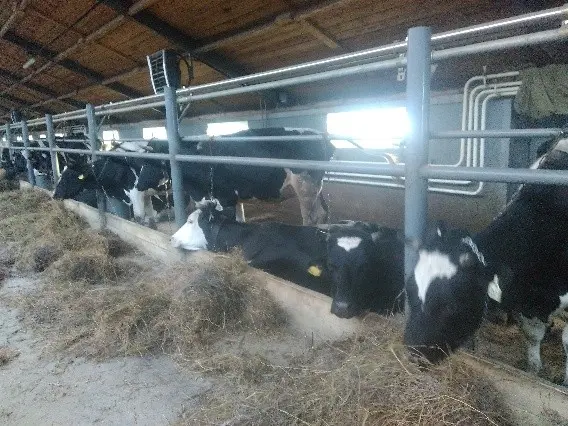
The dry season usually occurs in winter.
Features of keeping dry cows
The technology of keeping and feeding dry cows includes not only the calculation of the diet. Since these are infertile animals, the conditions of their maintenance must also be taken into account.
Methods:
- tethered;
- loose with deep bedding;
- loose-box.
Each method assumes a certain sanitary area for one cow. Since the dry period involves deep pregnancy, dry queens and heifers should account for at least 4 m² if the cattle are kept without a tie on a deep litter. Box size: 1,9×2 m. With the tethered method, stalls are used, the size of which is 1,2×1,7 m.
The content system can be:
- stall-pasture: use of pasture and farm building;
- stall-walking: paddocks for walking are adjacent to the farm, they are used in the absence of pastures, cows are kept in paddocks even in summer, providing them with freshly cut grass;
- camp-pasture: cattle are transferred to camps on pastures for the summer, the main premises are sanitized and repaired at this time;
- camp-stall: in the absence of grazing, cows are kept in pens around the clock, green fodder is delivered daily.
Large farms use a flow-shop system of milk production. With this method, cows calve all year round so that the conveyor is not interrupted. It is for mass production that it is very important that even in summer there are dry cows on the pasture, which calve after 2-3 months. For a private owner with one animal, this arrangement is unprofitable. It is better for him to raise a calf on free grass than to feed him expensive concentrates and hay in winter.
The flow technology of keeping dry, pregnant and dairy cows provides for the division of animals into groups depending on their physiological state. Of these groups form workshops:
- milk production;
- milking and insemination;
- abducted;
- dry cows.
The first workshop is the largest in terms of the number of livestock and the duration of keeping animals in it. It is allocated 50% of the total livestock and 200 days to stay in this department. Accordingly, for the calving shop – 11% and 25 days; for milking and insemination – 25% and 100 days; for dry cows – 14% and 50 days.
But if the types of content for a private owner are not of particular importance, then the system of rationed feeding of dry pregnant cows and heifers may well be applied to a personal farmstead.
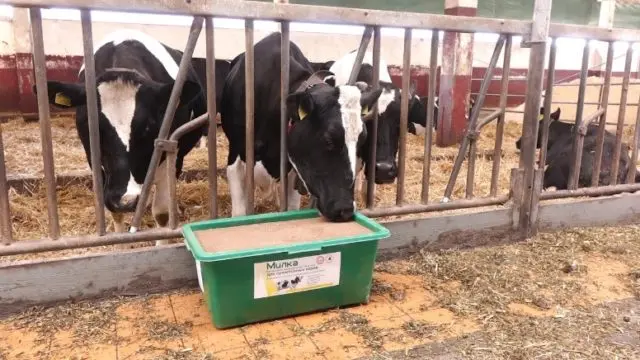
To fill the needs of dry cows in minerals, lick salt with appropriate additives is used.
The importance of a proper diet
Inadequate feeding often causes complications at and after calving, the birth of weak calves, poor development of offspring and low milk yields in the subsequent period. Due to the fact that the main problems with calves are “laid” in the last two months, special attention is paid to feeding cows during the dry period. At this time, the calf grows very intensively, and the weight of the queen of average fatness during the dry period increases by 10-15%. If the fatness of the cow is below average, then the weight gain is even greater.
Rules for feeding dry cows and heifers
The need for nutrients in adult dry cows is 1,5-2 feed. units per 100 kg live weight. Calculate the norm based on the average fatness. If the uterus is underweight, the norm is increased.
Excess feeding leads to animal obesity, which is the main cause of severe calving and postpartum complications. Rations for heifers and dry cows do not differ in structure, that is, animals receive the same feed. But there are serious differences in the rationing and percentage of feed.
Norms of feeding heifers
The cow grows up to 5 years, and she is covered in a year or two. Accordingly, the heifer brings the first calf, being no more than 3 years old. At this time, nutrients for growth are needed not only by her offspring, but also by the heifer itself. Because of this, the diets of heifers and dry cows differ from each other: the former require more feed units per 100 kg of live weight. Moreover, the diet is calculated based on the level of expected productivity and the duration of pregnancy.
In total, 5 periods of pregnancy are distinguished in young cows, which take into account not only the stage of embryo development, but also the weight gain of the animal itself. The average daily gain in heifers should be at least 0,5 kg.
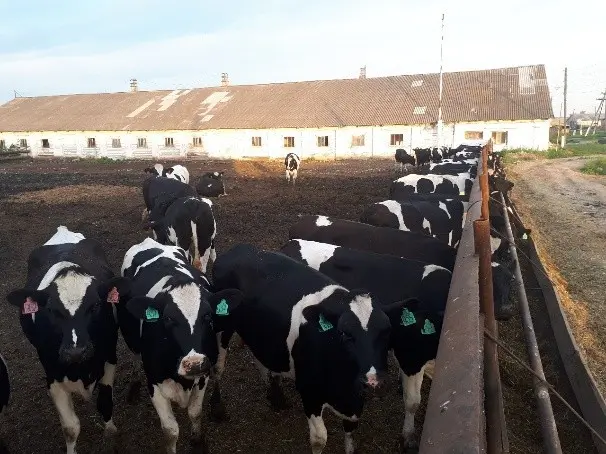
During the first pregnancy, the heifer is only 70% the size of an adult cow.
In the first period
The initial stage of pregnancy is 1-3 months. At this time, the weight of the heifer is 350-380 kg. At the first stage, the diet of heifers is the same as that of young bulls or barren individuals. At the first stage of pregnancy, animals do not yet need specific feeding. In total, the heifer should receive 6-6,2 feed. units per day. The preferred food is hay + root crops or grass.
In the second period
The second stage starts from the 4th month and ends on the 6th. By the beginning of the second trimester, the heifer should weigh 395-425 kg. But feeding rates are increasing slowly. At this stage, the young animal receives 6,3-6,5 feed. units per day.
Last trimester of pregnancy in heifers
For the last 3 months, the heifer begins to quickly gain weight: 440-455-470 kg. She needs more food. Every month they add 0,5 fodder to her. units: 7,0-7,5-8,0.
During the entire period of pregnancy, in addition to the nutritional value of the feed, other elements increase accordingly:
- phosphorus;
- calcium;
- magnesium;
- iron;
- sulfur;
- potassium;
- copper;
- other necessary micro and macro elements.
The need for vitamins D and E is also increasing. More detailed data on the needs of heifers during pregnancy can be found in the table:
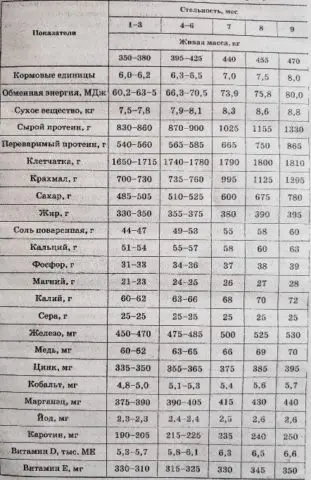
Norms of nutrients for heifers based on 1 individual per day
It is not necessary to cut their diet in the first decade of the eighth month of pregnancy.
Norms of feeding pregnant dry cows
The dry time takes only 2 months, but the calculation of the diet is quite complicated, since it is produced every ten days:
- I – the total level of feeding is 80% of the required, this is the “start” time;
- II – feeding rates are raised to 100%;
- III-IV – the norm is 120% of the usual diet;
- V – again lower the rate to 80%;
- VI – give 60-70% of the norm.
Feeding rates are calculated in feed units. But not only this is important. It is necessary that the uterus receives the required amount of protein. At the same time, it is not enough just to calculate how much crude protein an animal will receive. You also need to understand how much protein will be absorbed by the cow’s body. A lack of protein leads to dystrophy in a newborn calf.
Violation of the sugar-protein balance causes physiological immaturity and dyspepsia in calves. Normally, sugar should be related to protein as 0,8:1,0. Lack of carotene causes a decrease in the quality of colostrum, miscarriages and the birth of weak calves. With a lack of minerals and vitamin D, osteodystrophic diseases may occur in calves.
Nutrient requirements for feeding dry cows are shown in the table below. Calculation for 1 head per day.
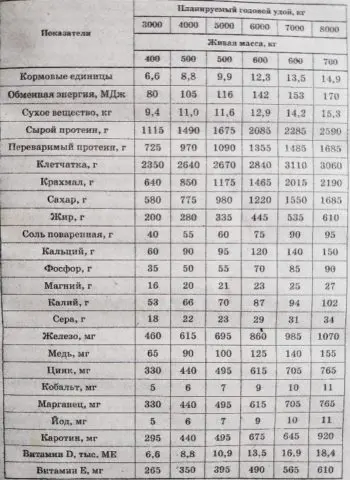
All norms are calculated for full-aged cows of average fatness
Young queens under the age of 5 years are added 5 feed. units and 0,5 kg of digestible protein per kg of live weight gain.
Features of feeding dry cows in different periods
Since, due to the in-line production of milk, dead queens are found on large farms even in summer, diets for them are developed depending on the time of year. The only general rule for dry cattle and heifers is to feed 2-3 times a day. But this is not about free pasture, but about the rationing of feed. Especially strictly monitor the amount of concentrates, since they can lead to obesity.
Feeding dry cows in winter
The diet of cattle in the winter period consists of three parts: roughage, root and tuber fruits, concentrates. The amount is calculated not by weight, but based on feed units:
- hay/straw – 50%;
- succulent feed – 25%;
- concentrate – 25%.
By volume, concentrates will be the least. On average, they account for only 1,5-2,0 kg by weight.
Feeding dry cows during the stall period
The stall and winter periods are usually equivalent concepts. In the summer, they try to keep livestock free-range. Animals are placed in the premises only after the grass completely disappears on the pastures. But there are situations when the farmer does not have extra land. In this case, the stall period continues year-round.
The difference is that in winter only hay is given to livestock, and in summer a significant part of the dry roughage is replaced with fresh grass. In summer feeding with stall keeping, cows are given:
- hay – 2-3 kg;
- silage – 2-2,5 kg;
- haylage -1-1,5 kg;
- root crops – 1 kg;
- grass – 8-10 kg.
All data are based on 100 kg of weight. That is, before calculating the diet and feeding norms, you need to find out the weight of the dead uterus or heifers. The number of concentrates is considered not for live weight, but for 1 head: 1,5-2 kg per day. The frequency of feeding is the same as in winter: three times a day.
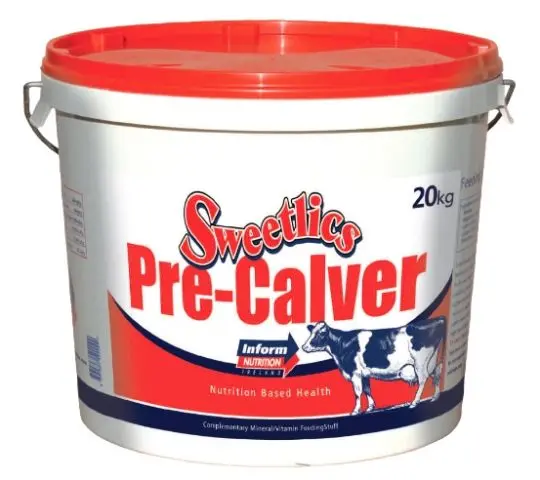
In the absence of a special lick salt, premixes are added to the feed mixture before distribution
Feeding dry cows in the pasture period
The transition from stall winter maintenance to summer grazing is carried out gradually. A sharp change from dry, but rich in fiber hay to young juicy grass causes an upset in the intestines. The microflora does not have time to rebuild. Diseases of the gastrointestinal tract lead to disruption of the normal course of pregnancy.
At first, heifers and dead queens, before pasture for grazing, are fed in the morning with hay, but not with concentrates. Saturated cows do not so greedily grab young, fiber-poor grass. Cereals in front of the pasture are contraindicated, since in combination with plant sap they can cause fermentation in the rumen. The duration of grazing is also increased gradually.
When grazing on a pasture, it is impossible to accurately control the amount of grass eaten by livestock. A cow can eat up to 100 kg of plants per day. Feeding during pasture grazing is carried out only when livestock are placed on the farm overnight. At this time, hay and concentrates are set.
On the pasture, the chemical composition of the soil is monitored, since the plants have nowhere to take various elements from, except from the ground. Control is necessary in order to know which bait is important for pregnant animals.
Grazing on natural and cultivated pastures has its pros and cons. On the natural richer species composition of plants. This allows the cow to choose what she needs. It is easier for the owner to control the nutritional value and chemical composition of the grass at the sowing plant.
The table shows the most common forage grasses and their main chemical composition.
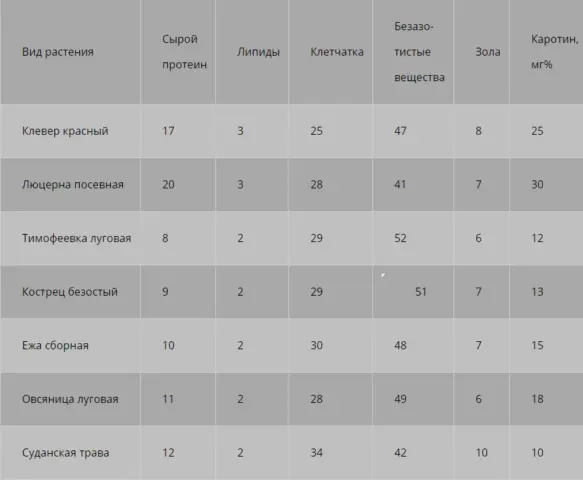
The nutritional balance of the cow is an important element of the harmonious flow of all periods of pregnancy
Norms and diets for feeding dry cows
Diet rates are calculated individually for each region, since the nutritional value and chemical composition of herbs directly depends on the soil. In one region, it is necessary to add iodine to livestock feed, in another it will cause diseases due to an excess of the element. There are areas poor in sulfur or zinc. Therefore, when compiling a diet, feed samples must be given for chemical analysis.
The nutritional value of hay also depends on the type of grass and the mowing time. Hay cut too soon or too late has a lower nutritional value than if harvested on time. Hay caught in the rain means minus 50% of the predicted nutritional value and amount of vitamins.

“Hospital average” nutritional value of the main feeds used in animal husbandry
It can be taken as a starting point, but should not be taken as an axiom.
feed requirements
Feed for dry pregnant cows and heifers, first of all, should not cause problems with the gastrointestinal tract. This means high quality requirements. Hay that has been exposed to rain is given very carefully. It may be moldy.
Silage intended for pregnant cattle should have a pleasant smell of sauerkraut. It is also better not to feed the rest of the sour cattle, of course. Concentrates should be free from musty or “mushroom” smells. Do not feed and frozen succulent feed.
When calculating feed units, they approach grain concentrates with particular care. For 1 feed units accepted 1 kg of oats. But most grains and legumes forage for livestock have a higher nutritional value:
- wheat – 1,06;
- barley – 1,13;
- peas – 1,14;
- soy and corn – 1,34.
The same applies to additives, such as cake and meal.
In succulent feed, due to the large amount of water, the nutritional value usually does not even reach 0,5 feed. units The nutritional value of hay and straw depends on the type of cut plants, drying conditions and harvesting time.
Feeding pregnant dry cows and heifers before calving
Immediately before calving, in the last decade of pregnancy, feeding rates are cut by 30-40% to avoid mastitis. Just at this time, the udder begins to swell in the uterus and colostrum is produced. Cows are transferred to feeding only hay, completely excluding concentrates and succulent feed.
What not to feed dry cows and heifers
Probably easier to say than you can: benign feed. Everyone else can’t. Do not feed dry pregnant cows and heifers:
- frozen roots and tubers;
- frozen silo;
- rotten and moldy food.
Not only is it impossible, but it is forbidden to feed heifers and dry cows with carbamide (urea) and other non-protein supplements containing nitrogen.

Spoiled potatoes should never be given to livestock
Conclusion
Proper feeding of dry cows lays the foundation for the future productivity of the uterus and allows you to get a quality calf. Attempts to save on feed or milk a cow for longer than possible lead to serious postpartum complications for both the queen and her offspring.









